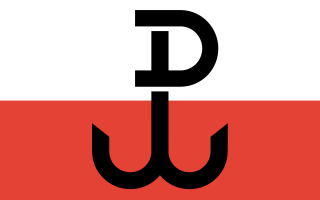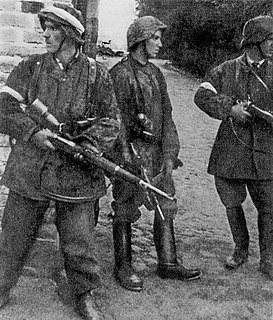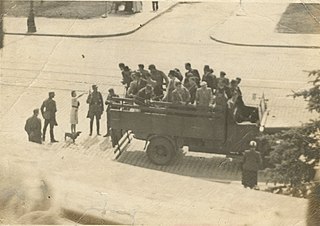
The Home Army was the dominant resistance movement in German-occupied Poland during World War II. The Home Army was formed in February 1942 from the earlier Armed Resistance established in the aftermath of the German and Soviet invasions in September 1939. Over the next two years, the Home Army absorbed most of the other Polish underground forces. Its allegiance was to the Polish government-in-exile in London, and it constituted the armed wing of what came to be known as the Polish Underground State.

Władysław Bartoszewski was a Polish politician, social activist, journalist, writer and historian. A former Auschwitz concentration camp prisoner, he was a World War II resistance fighter as part of the Polish underground and participated in the Warsaw Uprising. After the war he was persecuted and imprisoned by the communist Polish People's Republic due to his membership in the Home Army and opposition activity.

Witold Pilecki was a Polish cavalry officer, intelligence agent, and resistance leader. Early in World War II he co-founded the Secret Polish Army resistance movement.

Kedyw (Polish pronunciation: [ˈkɛdɨf], partial acronym of Kierownictwo Dywersji was a Polish World War II Home Army unit that conducted active and passive sabotage, propaganda, and armed operations against German forces and collaborators.

Franz Kutschera was an Austrian Nazi politician and government official. He held numerous political and military positions with the Nazi Party and the Schutzstaffel (SS) both before and after the German Anschluss of Austria in 1938. During World War II he served with the SS in France, Yugoslavia and the Soviet Union.

The Polish resistance movement in World War II, with the Polish Home Army at its forefront, was the largest underground resistance movement in all of occupied Europe, covering both German and Soviet zones of occupation. The Polish resistance is most notable for disrupting German supply lines to the Eastern Front, providing intelligence reports to the British intelligence agencies, and for saving more Jewish lives in the Holocaust than any other Western Allied organization or government. It was a part of the Polish Underground State.

Crimes against the Polish nation committed by Nazi Germany and Axis collaborationist forces during the invasion of Poland, along with auxiliary battalions during the subsequent occupation of Poland in World War II, consisted of the murder of millions of ethnic Poles and the systematic extermination of Jewish Poles. The Germans justified these genocides on the basis of Nazi racial theory, which regarded Poles and other Slavic peoples as racially inferior Untermenschen and depicted Jews as a constant threat. By 1942, the Nazi Germans were implementing their plan to kill every Jew in German-occupied Europe, and had also developed plans to eliminate the Polish people through mass murder, ethnic cleansing, enslavement and extermination through labor, and assimilation into German identity of a small minority of Poles deemed "racially valuable". During World War II, the Germans not only murdered millions of Poles, but ethnically cleansed millions more through forced deportation to make room for “racially superior” German settlers. The genocides claimed the lives of 2.7 to 3 million Polish Jews and 1.8 to 2.77 million non-Jewish ethnic Poles, according to various sources such as Poland's Institute of National Remembrance.

The issue of why the Allies did not act on early reports of atrocities in the Auschwitz concentration camp by destroying it or its railways by air during World War II has been a subject of controversy since the late 1970s. Brought to public attention by a 1978 article from historian David Wyman, it has been descried by Michael Berenbaum as "a moral question emblematic of the Allied response to the plight of the Jews during the Holocaust", and whether or not the Allies had the requisite knowledge and the technical capability to act continues to be explored by historians. The U.S. government followed the military's strong advice to always keep the defeat of Germany the paramount objective, and refused to tolerate outside civilian advice regarding alternative military operations. No major American Jewish organizations recommended bombing.

The "cursed soldiers" or "indomitable soldiers" is a term applied to a variety of anti-Soviet and anti-communist Polish resistance movements formed in the later stages of World War II and its aftermath by members of the Polish Underground State. The clandestine organisations continued their armed struggle against the communist regime of Poland well into the 1950s. The guerrilla warfare included an array of military attacks launched against the regime's prisons and state security offices, detention facilities for political prisoners, and concentration camps that were set up across the country. Most of the Polish anti-communist groups ceased to exist in the late 1950s, as they were hunted down by agents of the Ministry of Public Security and Soviet NKVD. The last known "cursed soldier", Józef Franczak, was killed in an ambush in 1963.

Szmalcownik ; in English, also spelled shmaltsovnik, plural sometimes given as szmalcowniki) is a pejorative Polish slang expression that originated during the Holocaust in Poland in World War II and refers to a person who blackmailed Jews who were in hiding, or who blackmailed Poles who aided Jews during the German occupation. By stripping Jews of their financial resources, blackmailers added substantially to the danger that Jews and their rescuers faced and increased their chances of getting caught and killed.

Polish Jews were the primary victims of the German-organized Holocaust in Poland. Throughout the German occupation of Poland, many Poles rescued Jews from the Holocaust, in the process risking their lives – and the lives of their families. Poles were, by nationality, the most numerous persons who rescued Jews during the Holocaust. To date, 7,112 ethnic Poles have been recognized by the State of Israel as Righteous among the Nations – more, by far, than the citizens of any other country.
Związek Organizacji Wojskowej, abbreviated ZOW, was an underground resistance organization formed by Witold Pilecki at Auschwitz concentration camp in 1940.

Stanisław Witold Aronson is a Polish Jew and an Israeli citizen, as well as a former officer of the Polish Home Army (AK) with a rank of Lieutenant Colonel. He was also a member of the Kedyw unit, "Kolegium A", of the Warsaw Region of AK, a participant in the Warsaw Uprising of 1944, and a Lieutenant Colonel of the Israeli Defense Force who took part in the 1947–1949 Palestine war, the Yom Kippur War and the 1982 Lebanon War.
Operation Heads was the code name for a series of assassinations of Nazi officials by the World War II Polish Resistance. Those targeted for assassination had been sentenced to death by Polish Underground Special Courts for crimes against Polish citizens during the World War II German occupation of Poland. The operation's code name, literally "Operation Little Heads", was a sardonic reference to the Totenkopf insignia on Nazi German SS uniforms and headgear.

Ronald Clarence Jeffery, also Józef Kawala, Stanisław Jasiński, Sporn and Botkin, was an English soldier and an agent of British and Polish intelligence during World War II. Jeffery was described by the Gestapo as "one of the foxiest devils in Europe".

Witold's Report, also known as Pilecki's Report, is a report about the Auschwitz concentration camp written in 1943 by Witold Pilecki, a Polish military officer and member of the Polish resistance. Pilecki volunteered in 1940 to be imprisoned in Auschwitz to organize a resistance movement and send out information about the camp. He escaped from Auschwitz in April 1943. His was the first comprehensive record of a Holocaust death camp to be obtained by the Allies.

The organization of underground resistance movements in Auschwitz concentration camp began in the second half of 1940, shortly after the camp became operational in May that year. In September 1940 Witold Pilecki, a Polish army captain, arrived in the camp. Using the name Tomasz Serafiński, Pilecki had allowed himself to be captured by Germans in a street round up (łapanka) with the goal of having himself sent to Auschwitz to gather information and organize resistance inside. Under Pilecki's direction the Związek Organizacji Wojskowej, ZOW, was formed.

'Izrael Kanał, also known as Mietek and Jehuda, was a Jewish resistance soldier in the Warsaw Ghetto and a participant of the Warsaw Ghetto Uprising in 1943.
Executions in the ruins of the Warsaw Ghetto (1943–1944) – mass executions of Polish Political prisoners and people of Jewish descent carried out secretly by German occupiers in the ruins of the Warsaw Ghetto.

Anna Maria Hinel,, Polish girl scout, activist of the underground independence movement during World War II, author of a diary from the German Nazi occupation.























